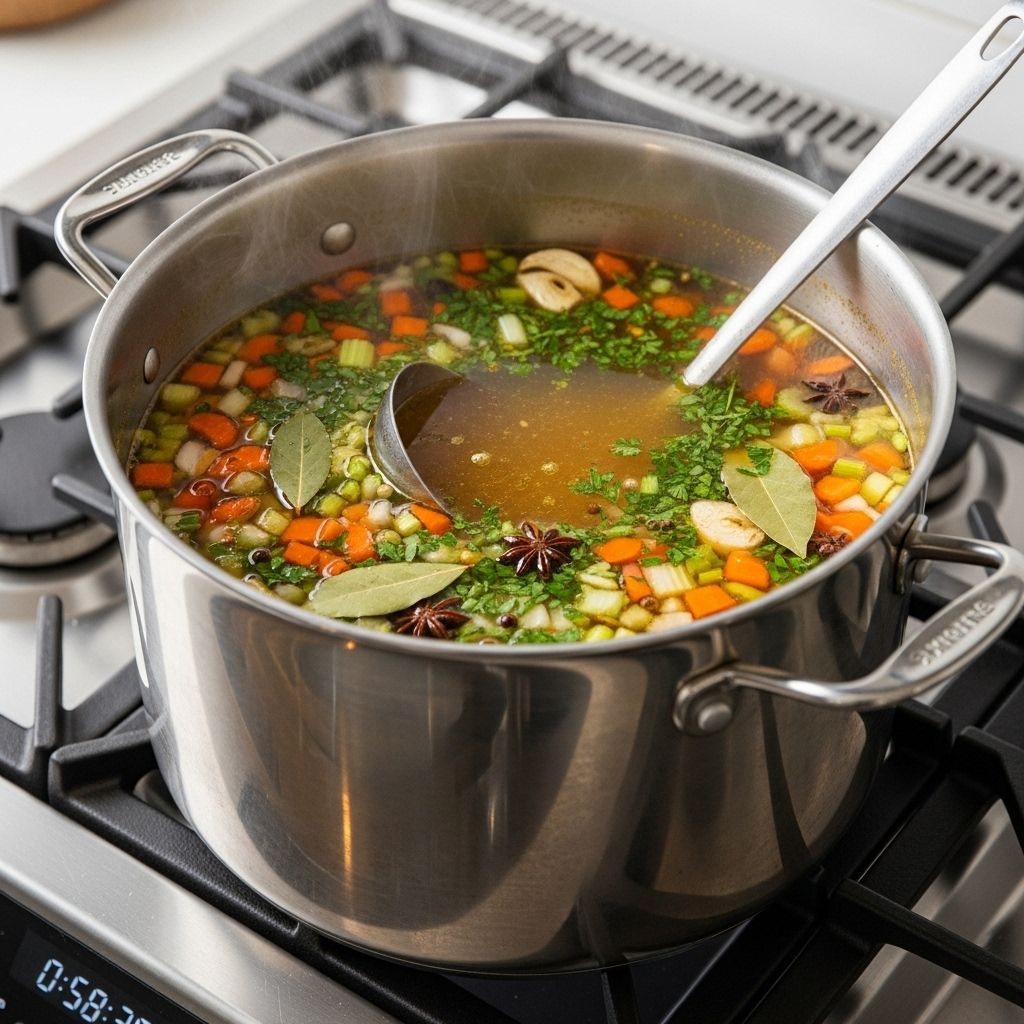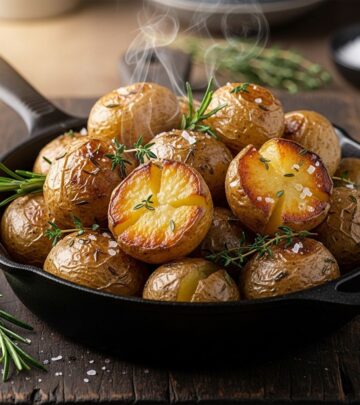Easy 1-Pot Vegetable Broth: Homemade Flavor in an Hour
Turn leftover veggie scraps into a nourishing kitchen essential bursting with rich flavor.

Easy 1-Pot Vegetable Broth
If you’re looking for a healthy, flavor-packed base for soups, stews, and risottos, homemade vegetable broth is the ultimate kitchen staple. This easy, 1-pot method transforms simple vegetables, fresh herbs, and everyday scraps into a deeply savory, mineral-rich broth—ready in under an hour.
Forget the bland boxed options. Crafting your own vegetable broth lets you use up kitchen scraps, control flavors, and avoid preservatives while packing your favorite soups with layers of homemade goodness.
Why Make Homemade Vegetable Broth?
- Flavor Customization: Adjust salt, herbs, and vegetables for perfect seasoning and preferred depth.
- Healthier Broth: No additives, MSG, or excess sodium. Fresh, clean ingredients only.
- Reduce Food Waste: Use up carrot peels, onion skins, wilting herbs, and veggie ends you might otherwise toss.
- Cost Effective: Save money by brewing broth from leftovers rather than buying cartons or bouillon cubes.
- Vegan and Gluten-Free: 100% plant-based and adaptable for all dietary needs.
Ingredients
This flexible recipe invites creativity. The core ingredients include standard aromatics, but see the pro tips below for extra flavor boosts and waste reduction ideas.
| Ingredient | Recommended Amount | Notes |
|---|---|---|
| Avocado or Coconut Oil | 1 Tbsp | Or sub with water for an oil-free broth |
| Onion (with skins) | 1 medium | Skins add color; finely chop for even cooking |
| Garlic (with skins) | 4 cloves | Adds depth and savoriness |
| Carrots (with skins) | 4 medium | Peels are fine; chop for faster simmering |
| Celery | 4 stalks | Include leaves for extra flavor |
| Sea Salt | 1-2 tsp | Start low, add to taste |
| Black Pepper | 1-2 tsp | Add more if desired |
| Filtered Water | 9-10 cups | |
| Sturdy Greens (kale, collards, etc.) | 1 cup, chopped | Optional but nutrient-rich |
| Fresh Parsley | 1/2 cup, chopped | Stems and leaves both great |
| Fresh Thyme | Small handful | Or use dried if unavailable |
| Fresh Rosemary | Small handful | Heightens aroma |
| Bay Leaves | 2 | Do not skip |
| Nutritional Yeast | 3-4 Tbsp | Optional, for umami (skip if allergic or unavailable) |
| Tomato Paste | 4-5 Tbsp | Adds sweetness and richness |
Optional & Add-in Ideas
- Mushrooms (fresh or dried) for earthy umami
- Leek tops, scallions, shallot peels
- Sweet potato or potato peels
- Red bell pepper scraps
- Herb stems: dill, chives, tarragon
- Ginger for warmth, especially in gut-soothing broths
- Seaweed (such as kombu) for minerals
Aim for variety—just avoid too many cruciferous (broccoli, Brussels) or starchy (potato) scraps that can overpower or cloud the broth.
How to Make 1-Pot Vegetable Broth
- Prep Vegetables: Wash all produce thoroughly. Finely chop onions, garlic, carrots, celery, and greens for more surface area and faster steeping. Leave skins and peels on for extra flavor and nutrients. Gather any cleaned, freezer-saved veggie scraps.
- Heat Oil (if using): Add oil or water to a large stockpot over medium heat. Sauté onions and garlic for 2-3 minutes, stirring, until fragrant and translucent—not browned.
- Add Remaining Vegetables & Herbs: Stir in carrots, celery, and any additional vegetable scraps. Cook for 3-4 minutes, letting their natural sweetness emerge.
- Season & Add Water: Sprinkle in sea salt and black pepper. Add the tomato paste and nutritional yeast (if using). Pour in filtered water, scraping up any caramelized bits.
- Add Greens and Fresh Herbs: Toss in kale (or other sturdy greens), parsley, thyme, rosemary, and bay leaves. Bring to a gentle boil.
- Simmer: Reduce heat to low, cover loosely, and let the broth simmer for 45 minutes to 1 hour, or until the flavor is deep and vegetables are tender. Stir occasionally and add water as needed to keep veggies barely submerged.
- Strain: Remove and discard (compost!) vegetable solids and herb stems, reserving the richly colored, aromatic broth. Taste and adjust salt or pepper, adding a squeeze of lemon if brighter flavor is desired.
- Cool & Store: Allow the broth to cool fully. Pour into jars or containers, or freeze in batches for later use. Broth keeps refrigerated 4-5 days, or frozen for up to 1 month.
Pro Tips for Perfect Vegetable Broth
- Don’t overcrowd with scraps. Too many starchy or bitter trimmings (like potato skins or cabbage) can make the broth cloudy or harsh. Balance with plenty of sweet and aromatic items.
- Keep it low simmer. Boiling the broth can turn it cloudy and flatten flavors, while a gentle simmer coaxes out sweetness and subtlety.
- Adjust acidity and salt at the end. Add a splash of apple cider vinegar or lemon juice if the broth tastes flat, and fine-tune salt only after broth has reduced to avoid over-seasoning.
- Customize nutrition. Stir in extra greens, turmeric, or seaweed early on for specialty broths—anti-inflammatory or mineral-rich!
- Save and freeze scraps often. Keep a bag in the freezer and add carrot peels, onion ends, celery leaves, and parsley stems throughout the week.
Ways to Use Vegetable Broth
- Soups & Stews: The classic use! From velvety pureed vegetables to hearty noodle or bean soups.
- Cooking Grains: Rice, quinoa, and farro absorb extra flavor when cooked in rich broth instead of water.
- Deglazing: Add a splash to sauté pans to scrape up saucy, caramelized fond.
- Sauces & Gravies: Use as the liquid base to add lightness and savor to vegan gravies.
- Sipping: Warm in a mug with extra herbs for a soothing, mineral-rich drink.
Variations & Flavor Additions
The basic formula provides great depth, but you can easily adapt the broth profile for specific cuisines:
- Asian-Inspired: Add ginger, lemongrass, coriander stems, or dried mushrooms for an earthy note; a piece of kombu for a mineral boost.
- Italian: Include basil stems, dried oregano, and tomato paste.
- Herby & Floral: Try lavender or sage for a springtime, aromatic broth.
- Gut-Soothing: Use ginger, turmeric, carrot, celery, and seaweed such as kombu. This variant is gentle and great for upset stomachs.
- Umami-rich: Add more nutritional yeast, sun-dried tomatoes, or shiitake mushrooms.
Storage & Meal Prep Tips
- Refrigerator: Store cooled broth in airtight containers for 4–5 days.
- Freezer: Freeze portions in jars, silicone molds, or zip bags. Lay bags flat to save space; use within 1 month for peak flavor.
- Portion Control: Freeze in 1- or 2-cup containers or ice cube trays for easy access when recipes call for “a splash” of broth.
- Labeling: Mark containers with the date so you never wonder how old the broth is.
Frequently Asked Questions (FAQs)
Can I use vegetable scraps exclusively?
Absolutely—scraps such as carrot peels, onion skins, leek tops, and herb stems work well. Just avoid brassica (broccoli, cabbage) and potato peels in large quantities, as these can make the broth too bitter or cloudy.
How can I make oil-free vegetable broth?
Simply sauté vegetables in water instead of oil at the start of the process. This keeps the broth lighter and is suitable for oil-free diets.
Do I need to peel my vegetables?
No! Peels from carrots, onions, and garlic add depth, color, and nutrients. Just wash them well to remove dirt or pesticides first.
Can I pressure cook vegetable broth?
Yes, you can use an instant pot or pressure cooker. Cook on high pressure for about 15–20 minutes, quick-release, check the flavor, and strain.
Is homemade broth healthier than store-bought?
Yes—homemade is lower in sodium, preservative-free, and fresher. You control the taste and nourishment. Store-bought broths may contain additives or lack depth of flavor.
What if my broth tastes bland?
If the flavor is too light, simmer for an additional 10–15 minutes or add more salt, a squeeze of lemon, or a spoonful of tomato paste at the end.
How do I compost the leftover solids?
Strained vegetable solids can be composted, making your broth both waste-reducing and eco-friendly!
Bonus: Sample Vegetable Broth Formula
| Vegetable | Amount | Purpose |
|---|---|---|
| Onion (skins on) | 1 medium | Aromatic base + color |
| Garlic (skins on) | 4 cloves | Umami & depth |
| Carrots (unpeeled) | 4 medium | Sweetness |
| Celery | 4 stalks | Savory notes |
| Parsley (w/ stems) | ½ bunch | Bright flavor & minerals |
| Thyme + Rosemary | Small handfuls | Herbal aroma |
| Bay Leaves | 2 | Earthy perfume |
| Tomato Paste | 4–5 Tbsp | Color & richness |
| Nutritional Yeast | 3–4 Tbsp | Umami (optional) |
| Filtered Water | 9–10 cups | Simmer liquid |
Other Comforting Soup Recipes
- 1-Pot Golden Curry Lentil Soup
- Creamy Fall Soup in Acorn Squash Bowls
- 1-Pot Chickpea Noodle Soup
- Tom Kha Gai Butternut Squash Soup
For more inspiration, discover a variety of nourishing, plant-based soups that pair perfectly with your homemade vegetable broth!
Frequently Asked Questions (FAQs)
Q: Can I freeze homemade vegetable broth?
A: Yes. Let broth cool completely, then portion into jars or freezer-safe bags. Leave room for expansion. Use within a month for best taste.
Q: How do I make my broth more flavorful?
A: Use a greater variety of aromatics—herbs, mushrooms, and tomato paste. Try a longer simmer and finish with a dash of lemon juice for freshness.
Q: What vegetables should I avoid when making broth?
A: Use cruciferous vegetables (broccoli, cauliflower, Brussels sprouts) and excess potato skins sparingly to prevent bitterness or cloudy broth.
Q: Is this recipe gluten-free and vegan?
A: Yes. The ingredients are naturally free of gluten and animal products, provided you use gluten-free nutritional yeast if necessary.
Q: Which herbs are best for broth?
A: Parsley, thyme, rosemary, and bay leaves are classic. Experiment with chives, dill, or sage for different flavor profiles.
References
- https://minimalistbaker.com/easy-1-pot-vegetable-broth/
- https://minimalistbaker.com/simple-but-perfect-vegetable-soup/
- https://www.youtube.com/watch?v=GqkiMlRKQwg
- https://app.samsungfood.com/recipes/10100d1e27d6fe6ccd18ca5fd475019a8112d1c4864
- https://minimalistbaker.com/gut-calming-vegetable-broth-miso-tonic/
Read full bio of medha deb












